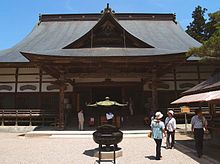- Chūson-ji
-
Chūson-ji (中尊寺) is a Buddhist temple in Hiraizumi, Iwate Prefecture, Japan. It is the head temple of the Tendai sect in Tōhoku (northeastern Japan). The Tendai sect claims that the temple was founded in 850 by Ennin, the third chief abbot of the sect, but most scholars believe that Chūson-ji was founded by Fujiwara no Kiyohira in about 1100. There is no archaeological or historical record of Buddhist activity in this area before 1100.
The Konjiki-dō (金色堂) or 'Golden Hall' is a mausoleum containing the mummified remains of the leaders of the Northern Fujiwara clan who ruled much of northern Japan in the 12th century. It is one of two buildings that survive from the original Chūson-ji temple complex, the other being a sutra repository.
The Konjiki-dō is one of the most beautiful and elaborately decorated buildings in the world. It is made of wood entirely covered with gold leaf decorated with imported mother-of-pearl. It was carefully rebuilt from 1962 to 1968 by a team of specialists. It is a square building measuring five-and-a-half meters on each side and eight meters tall. The interior of the building contains three altars, one for each of the first three Fujiwara lords. Originally there were 33 sculptures inside the temple, eleven on each altar, but now one is missing. Each altar had a seated Amida surrounded by standing Kannon and Seishi, six Jizō and two Niten statues. One Niten figure is missing.
The mummies were last examined in 1950. It is assumed that the mummy of Fujiwara no Kiyohira was placed under the central altar. Fujiwara no Motohira's remains were identified as he is known to have died of a cerebral hemorrhage. His mummy was found under the northwest altar. Fujiwara no Hidehira's remains were found under the southwest altar next to a casket containing the head of his son Fujiwara no Yasuhira who was beheaded in 1189.
The Konjiki-dō formerly sat outdoors in the open air. Later a wooden building was built around it to protect it from the elements. Now it sits in a concrete building behind thick acrylic glass and is only visible from the front.
In June 2011, Chūson-ji was listed as a UNESCO World Heritage Site as a part of the "Historic Monuments and Sites of Hiraizumi".
See also
- List of Special Places of Scenic Beauty, Special Historic Sites and Special Natural Monuments
- List of National Treasures of Japan (paintings)
- List of National Treasures of Japan (sculptures)
- List of National Treasures of Japan (writings)
- List of National Treasures of Japan (crafts-others)
- For an explanation of terms concerning Japanese Buddhism, Japanese Buddhist art, and Japanese Buddhist temple architecture, see the Glossary of Japanese Buddhism.
External links
- Official Chūson-ji website in Japanese
39°00′05″N 141°05′59″E / 39.001446°N 141.099833°ECoordinates: 39°00′05″N 141°05′59″E / 39.001446°N 141.099833°E (Konjikidō)
Buddhist temples in Japan Japanese Buddhist architecture Architectonic elements Mon (gates) Buildings Chinjusha · chōzuya/temizuya · -dō · main hall (kon-dō, hon-dō, butsuden) · kuri · kyōzō or kyō-dō · shoinTō or Buttō (pagodas) Styles Others A-un · kenSchools and objects of worship Major schools Zen schools Nanto rokushū Objects of worship Amida Nyōrai · Benzaiten · Dainichi Nyorai · Jizō · Kannon · Marishi-ten · Shaka Nyorai · Shitennō (Four Kings) · Twelve Heavenly Generals (Jūni Shinshō) · Yakushi NyoraiOther elements Implements kei (ritual gong) · mokugyōOthers bussokuseki · butsudan · Glossary of Japanese Buddhism · Japanese Buddhist pantheon · jingū-ji · miyadera · saisenbakoCategories:- Buddhist temples in Iwate Prefecture
- Heian period
- Nara period
- 850 establishments
- National Treasures of Japan
- Special Historic Sites
Wikimedia Foundation. 2010.


